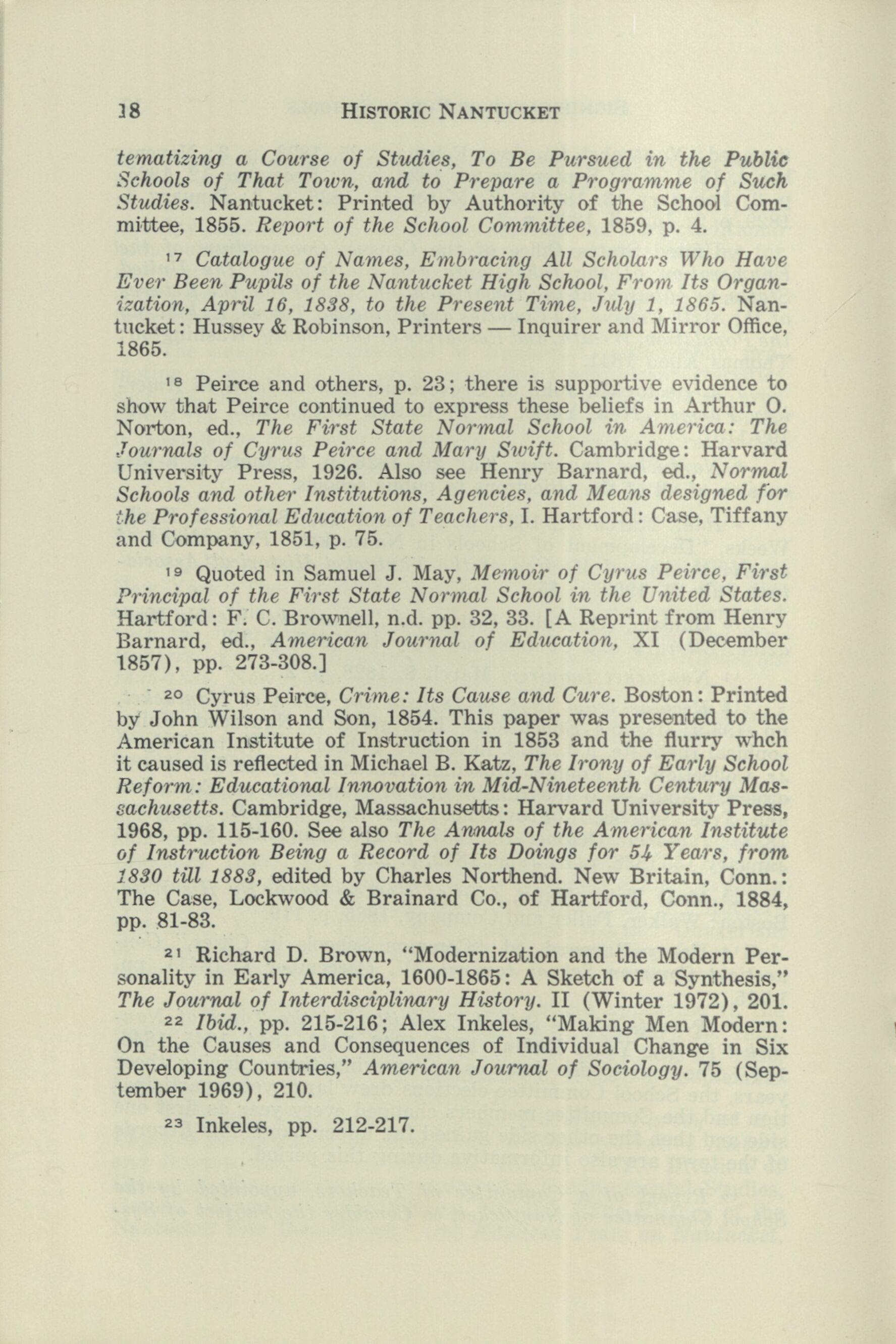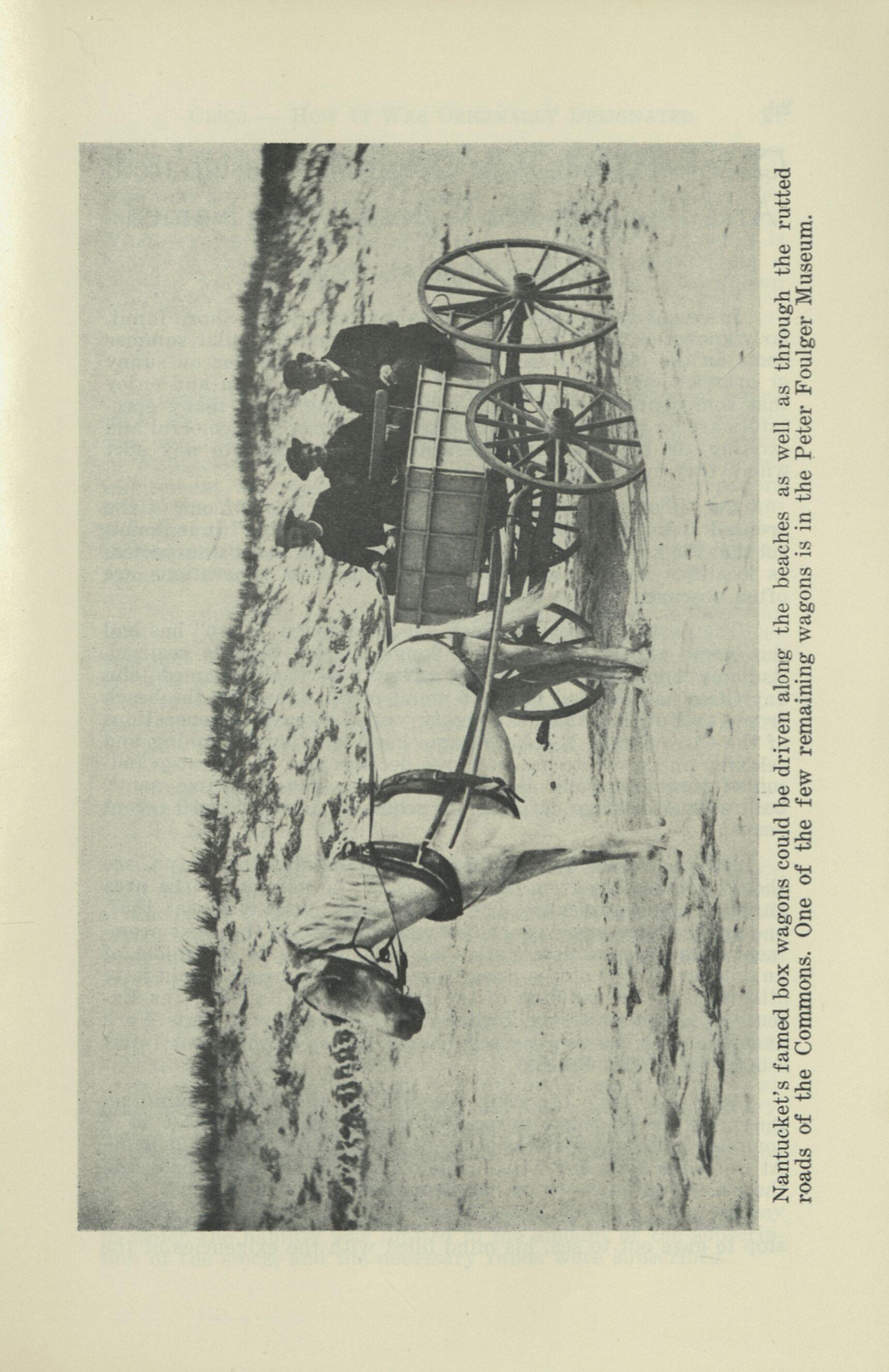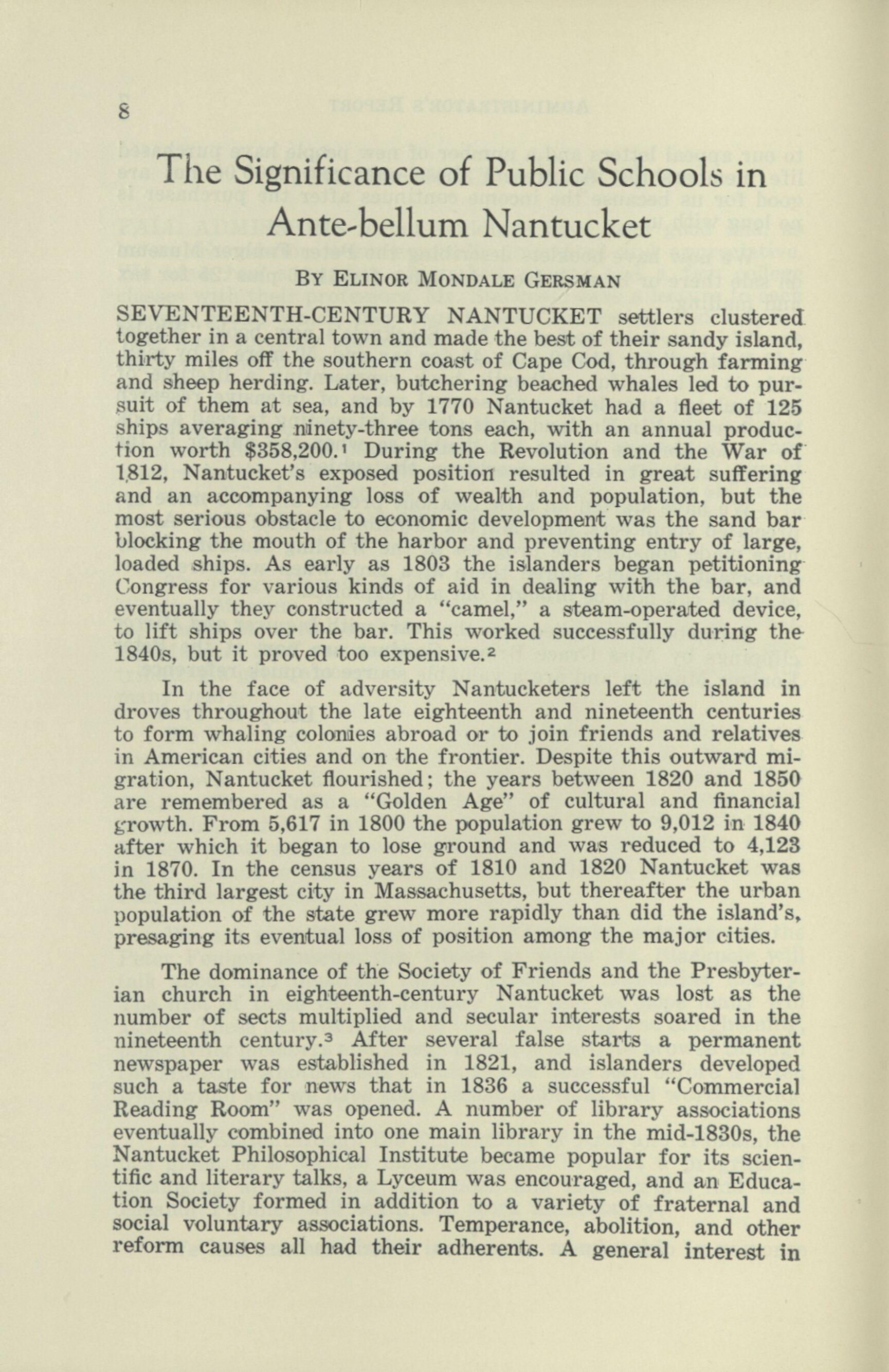
21 minute read
The Significance of Public Schools in Ante-Bellum Nantucket
8
BY ELINOR MONDALE GERSMAN
SEVENTEENTH-CENTURY NANTUCKET settlers clustered together in a central town and made the best of their sandy island, thirty miles off the southern coast of Cape Cod, through farming and sheep herding. Later, butchering beached whales led to pursuit of them at sea, and by 1770 Nantucket had a fleet of 125 ships averaging ninety-three tons each, with an annual production worth $358,200.' During the Revolution and the War of 1,812, Nantucket's exposed position resulted in great suffering and an accompanying loss of wealth and population, but the most serious obstacle to economic development was the sand bar blocking the mouth of the harbor and preventing entry of large, loaded ships. As early as 1803 the islanders began petitioning Congress for various kinds of aid in dealing with the bar, and eventually they constructed a "camel," a steam-operated device, to lift ships over the bar. This worked successfully during the 1840s, but it proved too expensive.2
In the face of adversity Nantucketers left the island in droves throughout the late eighteenth and nineteenth centuries to form whaling colonies abroad or to join friends and relatives in American cities and on the frontier. Despite this outward migration, Nantucket flourished; the years between 1820 and 1850 are remembered as a "Golden Age" of cultural and financial growth. From 5,617 in 1800 the population grew to 9,012 in 1840 after which it began to lose ground and was reduced to 4,123 in 1870. In the census years of 1810 and 1820 Nantucket was the third largest city in Massachusetts, but thereafter the urban population of the state grew more rapidly than did the island's, presaging its eventual loss of position among the major cities.
The dominance of the Society of Friends and the Presbyterian church in eighteenth-century Nantucket was lost as the number of sects multiplied and secular interests soared in the nineteenth century.3 After several false starts a permanent newspaper was established in 1821, and islanders developed such a taste for news that in 1836 a successful "Commercial Reading Room" was opened. A number of library associations eventually combined into one main library in the mid-1830s, the Nantucket Philosophical Institute became popular for its scientific and literary talks, a Lyceum was encouraged, and an Education Society formed in addition to a variety of fraternal and social voluntary associations. Temperance, abolition, and other reform causes all had their adherents. A general interest in
navigation provided incentive for the scientific observations of the astronomer, William Mitchell, and his more famous daughter, Maria, who formed the core of an intellectual elite on the island.4
Municipal safety and improvements were a major concern to Nantucketers during this period. Public provision was made for the poor, diseased persons were isolated, the town was cleaned, and drainage was encouraged; by 1854 public opinion permitted the town to order that all citizens be vaccinated. Firefighting equipment was given high priority in the town budget and so was the town clock, that symbol of modern efficiency, erected in 1823. People were delighted with the prospect, and the successful operation, of a regular connection with the mainland by steamer. Street lighting became a progressively more popular cause, eventually supported by public funds.5
The wealth of the town became more apparent as Quaker objections to obvious consumption were ignored. Whole streets of expensive houses, some built of brick and all in the newest styles, sprang up. In 1840 Nantucket County had the second highest valuation of property per person — $674.03 — in Massachusetts. Construction was booming in ships, housing and furniture. Ropewalks, whale oil refineries and grist mills provided jobs although the largest number of men in any single industry, 1,614, still navigated the oceans.6
Public schools were simply one more example of the intense interest in improvement and progress; this may be true everywhere, but it is particularly clear in Nantucket where there were no public schools until 1827 despite the Massachusetts laws, although private schools abounded. These schools had only a minor role in the education of Nantucketers, and J. Hector St. John de Crevecoeur described this role when, after two pages of eulogy for the education inculcated by home, religion, and society on the island, he said: At schools they learn to read, and to write a good hand, until they are twelve years old; . ... 7 And then he continued with the apprenticeship which fit young men for the whaling industry and for business. Both the Quakers and the whalers supported the unorganized, private approach to schooling; the Quakers feared having their children mingle with non-Quakers while the whalers, aristocrats that they were, feared that indiscriminate schooling would generate pride and cause whaling to die out for educated young men might choose not to follow such a harsh occupation.8
There were two causal factors in the establishment of public schools in 1827: one was a new state school law passed early in the year with a heavy penalty for noncompliance, and the other was the development of a strong public demand for public schooling as the islanders turned away from traditional leader-

10
HISTORIC NANTUCKET
ship. Nantucket citizens brought the dereliction of the town to the attention of a Grand Jury, for the first time, causing the town to be placed under indictment. Quickly the town elected a School Committee, voted $2,500 for "Free Schools," and opened the doors of the new public schools in July. So great was the demand that in 182,8 the School Committee was forced to exclude all applicants under nine years of age until more spaces could be provided, and by 1831 there were 805 children attending public schools.9
One of the strongest arguments supporting public schooling in Nantucket was based on the importance attached to a standardized level of behavior in which morality, self-discipline and punctuality were the keys. In 1817 a column in a short-lived Nantucket paper said: In a public school, children imbibe a sameness of thinking, and an uniformity of reasoning, which is productive of much subsequent harmony and friendship. But children scattered among numerous private schools, come out thence with feelings, and ideas as discordant as their manners are various, and their masters variable. — They have no such sentiments of common interests and equal advantages which they would derive at a public school.'0 Nantucket introduced an adapted monitorial system thinking it would be the form of schooling most conducive to developing the desired behavior. The knowledgeable editor of the Nantucket Inquirer wrote in 1828:
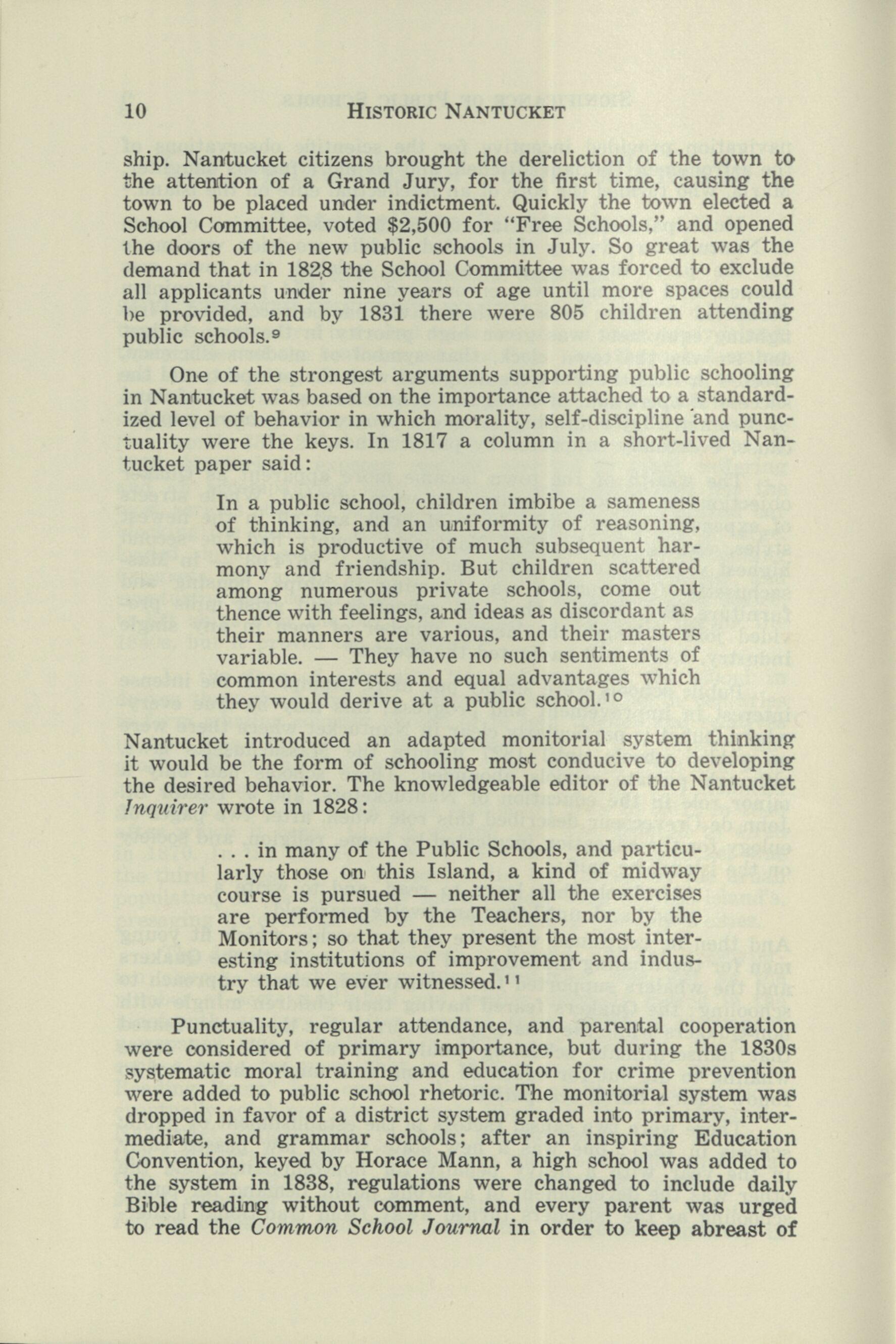
. . . i n m a n y o f t h e P u b l i c S c h o o l s , a n d p a r t i c u larly those on this Island, a kind of midway course is pursued — neither all the exercises are performed by the Teachers, nor by the Monitors; so that they present the most interesting institutions of improvement and industry that we ever witnessed.''
Punctuality, regular attendance, and parental cooperation were considered of primary importance, but during the 1830s systematic moral training and education for crime prevention were added to public school rhetoric. The monitorial system was dropped in favor of a district system graded into primary, intermediate, and grammar schools; after an inspiring Education Convention, keyed by Horace Mann, a high school was added to the system in 1838, regulations were changed to include daily Bible reading without comment, and every parent was urged to read the Common School Journal in order to keep abreast of
the latest developments.12 Horace Mann said of Nantucket in 1839:
Did all parts of the State receive me as cordially and pay half as much attention to my views, as the good people of Nantucket, there would soon be a common-school revolution in the state.13
In 1841 Henry Barnard praised the Nantucket schools saying they offered an example of a really complete system of education for children from the age of four to the age of eighteen.14
Because a number of freed blacks were attracted to the island by the booming economy, Nantucket faced the problem of racial integration during the 1840s. Abolitionists and one or two strong black leaders led the battle against the traditionally oriented segregationists. Integration rhetoric was based on the individual's right to the means of self-improvement and progress and the importance of a "common fountain of knowledge, from which all should draw freely" thus advancing the "utility, harmony, and beauty of the system." The belief in systematization and in self-improvement through schooling, a black boycott of segregated classes, and an economic squeeze combined to settle the question of race relations on the island in favor of integration and equality of treatment.15
The desire for standardization came to full fruition during the 1850s. A committee of teachers drew up a report which detailed, with charts, exactly what books and what lessons were to be taught to children in each grade and at what ages children would enter and leave each of the schools. In 1859 the School Committee noted with pride that years of extolling regularity and punctuality were winning success; attendance had improved greatly at the high school and the grammar schools where pupils were no longer permitted to enter if they were late.16

The public schools did not replace the private schools in Nantucket. Newspaper advertising continued to announce the openings and the terms of both day and evening schools for the "common branches," nautical and business studies, college preparation, and cultural lessons. These classes boomed during the economic and population growth of the 1830s, but slacked oif as much as eighty percent in the years after the devastating 1846 Ore which destroyed the entire business district and is credited with starting the degeneration of Nantucket's economic life, a degeneration hurried by the California gold rush and the Civil War. However, at least one academy, a number of common schools, and many "cent" schools, a nineteenth-century Nantucket version of dame schools, continued to survive for most of the century.
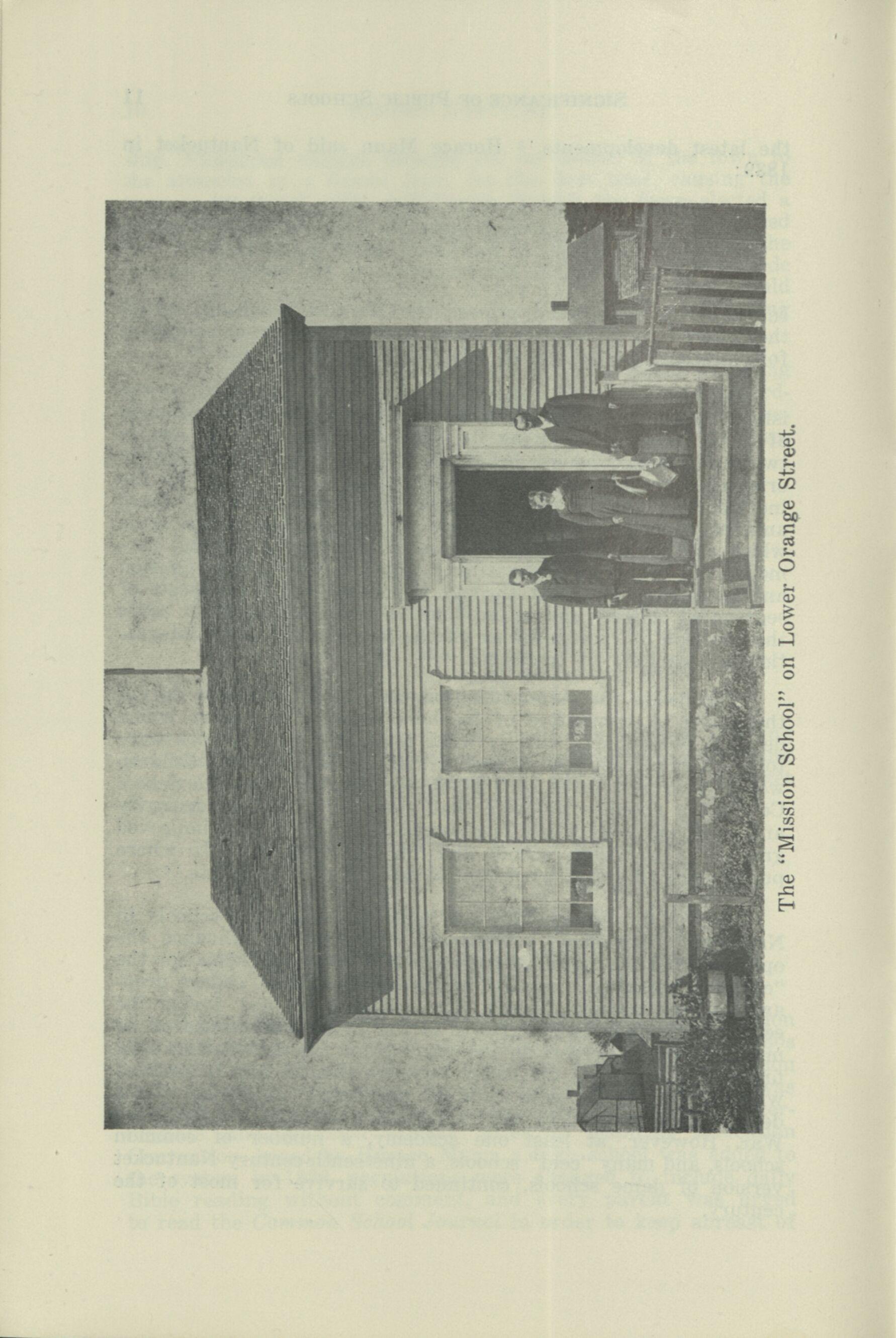
Public education was highly useful for the ambitious and may have been responsible for producing a high degree of mobility, if the tentative evidence drawn from a sampling of a list of all high school students between 1838 and 1865 can be accepted as meaningful. Between 1840 and 1865 the population of Nantucket dropped 46.7% from 9,012 to 4,830. This means that 53.3% of the population remained on the island. But of the students attending the high school between 1838 and 1865 only 30% remained. Such a large difference in mobility between the population as a whole and the high school population is quite striking and needs further study.17
Symbolic of the highest ideals of the more verbal and reformoriented Nantucketers throughout this period was Cyrus Peirce who was brought to Nantucket in 1810 as a young Harvard graduate to teach school. During the next forty years his life was intimately intertwined with that of the island; he married a Nantucket woman and, when he was not actually living on the island, he was a frequent visitor. He studied theology and became a minister, but eventually decided to devote his life to teaching.
Peirce's frequently reiterated rejection of competition and awards, such as were used in the monitorial system to motivate students, was characteristic of his evolving instructional principles. "Whatever advantages may be gained to learning from resorting to this principle," he said, "is more than counter balanced by the decidedly bad moral tendency, . . ." which tended to arouse a sense of power and greed rather than a love of knowledge and truth.18 Inextricably related to this belief in the power of knowledge was Peirce's determination to avoid use of physical punishment in teaching because "I could see that it often shocked, disturbed, but did not exalt the moral sentiment of the school." He explained that he had talked to many people about this and; I think it "was after listening to a conversation from Mrs." Mott, [Lucretia Mott] at Nantucket, in 1827, that I definitely formed the resolution • ;• . to attempt thenceforward to keep school without the intervention, (for I can say aid,) of blows.19 Thus he combined the power of knowledge with the power of moral self-dicipline as motivational devices in his teaching while rejecting all external motivational incentives.
During the 1830s Peirce conducted an excellent, very expensive private school in Nantucket; he led the movement to grade the public schools; he participated ardently in abolitionist and temperance activities ; he presented frequent talks on science and education; and he was a leader in the efforts of reformers, beginning in 1837, to support and follow Horace Mann. When the high school was established in 1838, Peirce was persuaded, at a
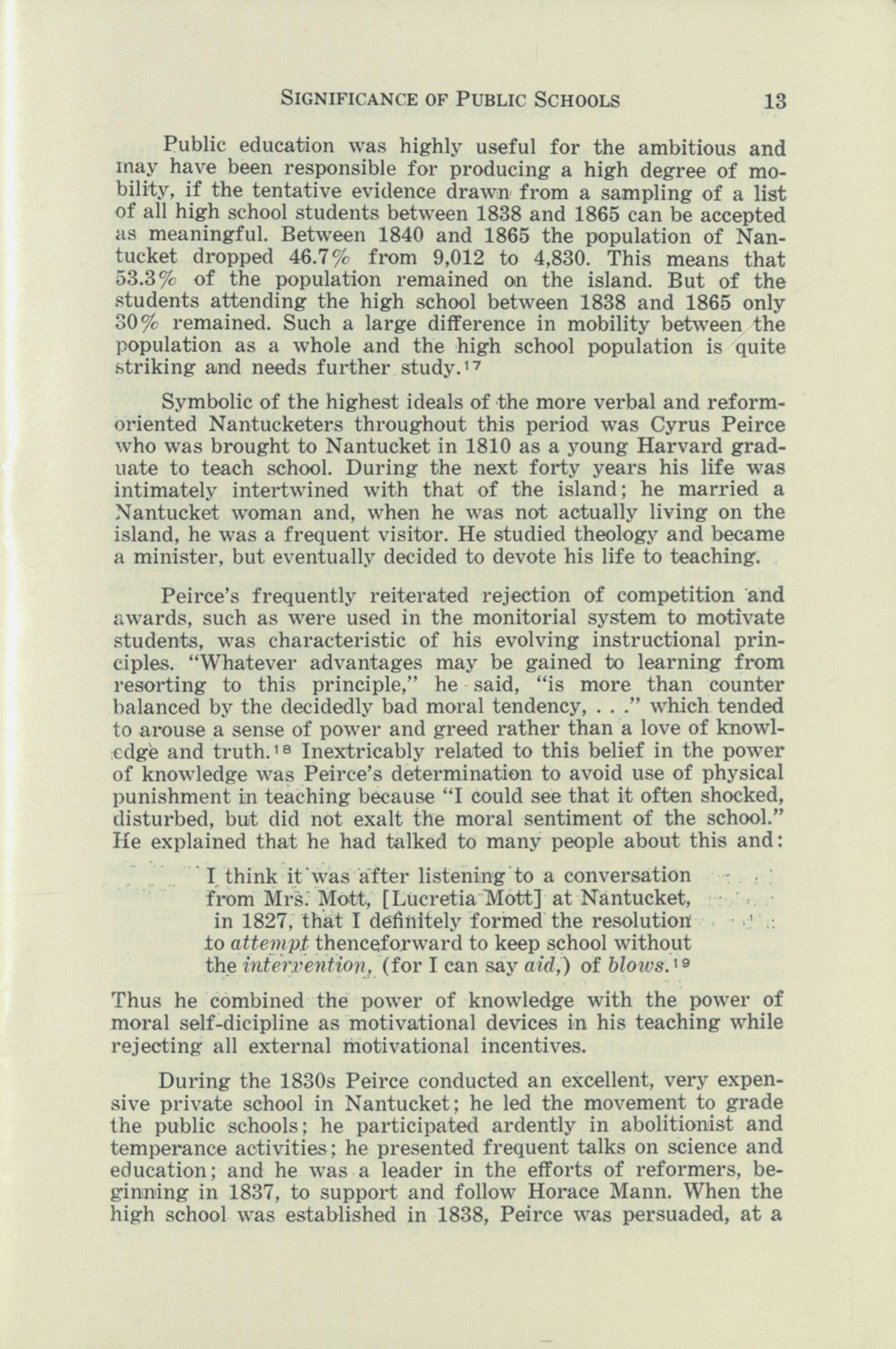
14
HISTORIC NANTUCKET
personal financial loss, to become the principal and, after little more than a year, he was tapped by Horace Mann to head the first public Normal School at Lexington, Mass. Peirce was remembered by his students as an excellent teacher who demanded and got a high level of performance; he treated students with dignity and kindness, he experimented with teaching methods in order to get good results, and he worked around the clock himself in order to meet his own expectations. He was always pleased when his students were punctual, prepared and attentive; his mood became depressed when attendance was not regular. Internal discipline and love of true knowledge which he believed to be the most successful motivational factors were inculcated both by precept and direct instruction, but he also insisted that schools must give direct moral instruction in order to prevent the growth of crime in society.20
With its unique industry and location, Nantucket might have developed any other system of schooling or continued to resist public schooling altogether. Instead the town enthusiastically supported the ideas of reformers and put them into practice. This paper has noted the events and will briefly suggest an explanation.
Richard D. Brown has recently suggested that the concept of modernization, widely used in the social sciences to explain differences and changes in human beings, has an important place in history. He writes: In the modern personality secular-rational values are dominant, ascribed status has become subordinate to functional status, mobility possesses a positive value, and an empathic, cosmopolitan outlook is typical.21 In order to be more specific, Brown cites the description of the modern personality which has been provided by Alex Inkeles after extensive study in six developing nations: Central to this syndrome [of a modern man] are: (1) openness to new experience, both with people and with ways of doing things . . .; (2) assertion of increasing independence from the authority of traditional figures like parents and priests and a shift of allegiance to leaders of government, public affairs, trade unions, cooperatives, and the like; (3) belief in the efficacy of science and medicine, and a general abandonment of passivity and fatalism in the face of life's difficulties; and (4) ambition for oneself and one's children to achieve high occupational and educational goals. Men who mani-
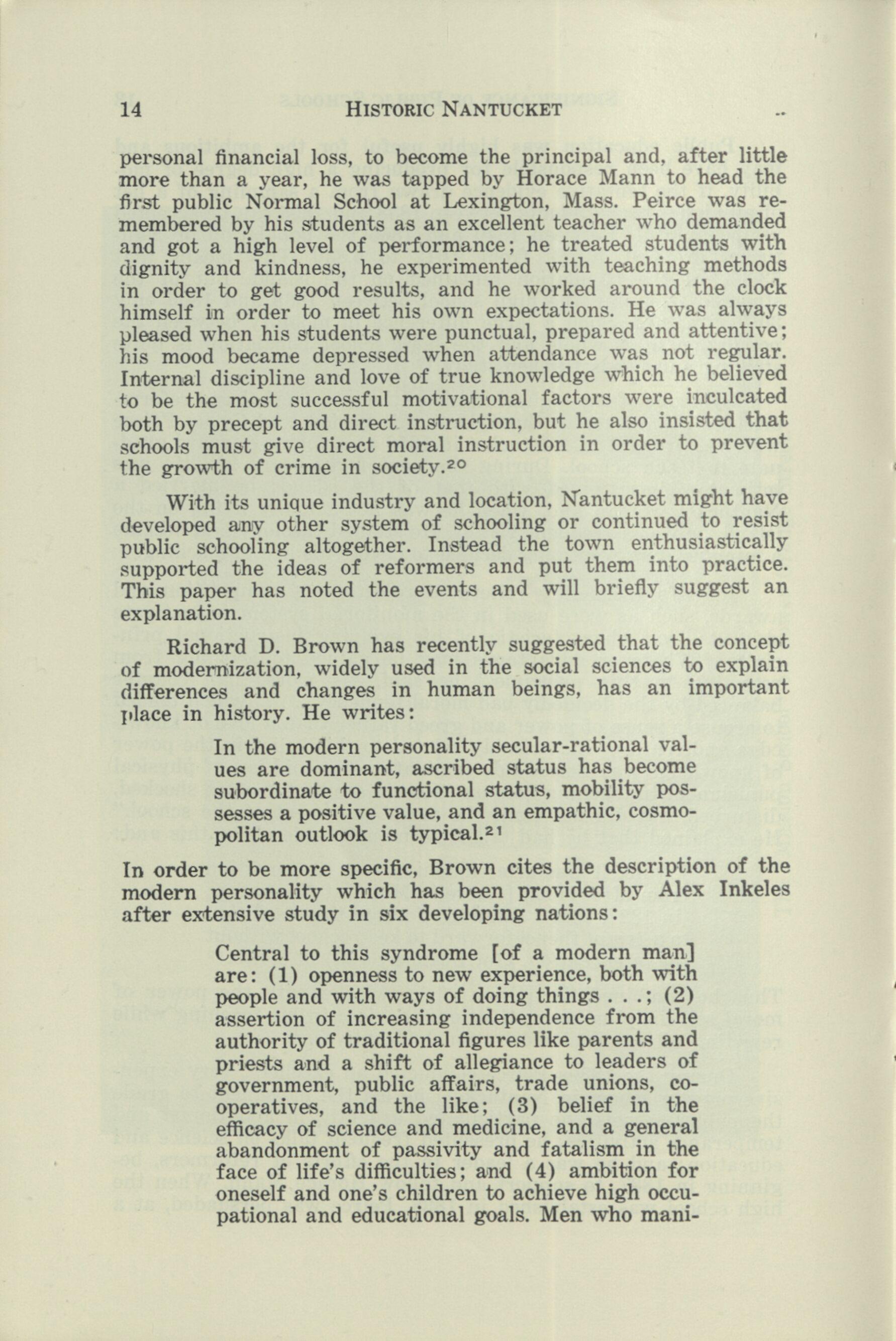
fest these characteristics (5) like people to be on time and show an interest in carefully planning their affairs in advance. It is also part of the syndrome to (6) show strong interest and take an active part in civic and community affairs; and (7) to strive energetically to keep up with the news, and within this effort to prefer news of national and international import over items dealing with sports, religion, or purely local affairs.22 This syndrome of the modern personality explains the changes taking place in Nantucket by setting up a model which clarifies the more vocal islanders' values and motives.
There may have been a time when Nantucketers could have chosen to remain a sleepy rural community with small fishing interests. But the choice of whaling as a chief occupation encouraged modernization of thoughts and values. Progress in whaling meant larger ships making longer voyages over greater distances. Improved skills and greater understanding in shipbuilding and navigation were essential. Mapping new parts of the globe, speculating about possible explanations of observed natural phenomena, and trying new approaches to surmount obstacles all resulted from the changing and experimental nature of whaling. Whaling forced men to gamble, to plan ahead for all possible contingencies and, as ships traveled further, to take an interest in foreign news.
At home Nantucketers lived in a town because the port was their main focus. The clustered wooden buildings prompted a civic interest in fire control, street lighting and other improvements; the usual problem of any port — transient sailors, diseases and safety hazards — prompted other kinds of public interest and action. These kinds of interests could be explained by the need for cooperative action growing out of municipal life, but it is not sufficient to explain the Nantucketer's openness to new ideas, the shift from traditional religious groups, and the multiplicity of voluntary associations. Nor is it adequate to to explain the new emphasis on punctuality, regularity, and standardization of experience and behavior which permeated the temperance and abolition movements as well as the educational and other reform groups, whereas modernization can.
Among the influences which make a man modern, Inkeles cites the school, the effects of which "reside not mainly in its formal, explicit, self-conscious pedagogic activity, but rather are inherent in the school as an organization."23 If mobility is a measure of modernization, then the Nantucket experience with high school students would support Inkeles idea of the school's

16
HISTORIC NANTUCKET
importance. It could be argued that men who fought for the public schools were already modernized and for that reason they saw the school was a means of promoting punctuality, regularity, and morality; and that they had already rejected the more traditional home, church and society as teachers. They were looking for new ways of teaching. Their solution, the schools, increased the adherence to a modern value system among its young charges, thus speeding the social changes.
The unique characteristics of Nantucket, rather than promoting a traditional life style, rewarded modern characteristics such as planning, mobility, and secular-rational values even before the nineteenth century. This development, in turn, made it possible for Nantucket to respond to the message of- reformers promptly and with enthusiasm.
Footnotes 1 John R. Spears, The Story of the New England Whalers. New York: The Macmillan Company, 1908, pp. 70-71. The discussion in this book is very useful and should be supplemented with the interesting study by Edouard A. Stackpole, The SeaHunters: The Netv England Whalemen During Two Centuries 1635-1835. New York: Bonanza Books, c. 1953. 2 "What the Camels Were Doing in 1,845," One Hundred Years on Nantucket 1821-1921. The Inquirer and Mirror Centennial Number, c. 1921. Unpaged. 3 There are a number of good studies of the Quaker religion but those which help clarify the Nantucket situation are: Burnham N. Dell, "Quakerism on Nantucket," Historic Nantucket, 2 (January 1955), pp. 8-30; Robert W. Doherty, The Hicksite Separation: A Sociological Analysis of Religious Schism in Early Nineteenth Century America, New Brunswick, N. J.: Rutgers University Press, c. 1967; Henry Barnard Worth, "Quakerism on Nantucket Since 1800," Nantucket Historical Association Bulletin, I (1896), pp. 3-38. 4 The following are a few of the notices appearing in the Nantucket Inquirer: October 18, 1821, p. 3; February 25, 1823, p. 3; January 24, 1825, p. 3; April 11, 1825, p. 3; June 24, 1826, p. 2; November 21, 1829, p. 2; September 6, 1835, p. 3; September 27, 1835, p. 2; October 26, 1836, p. 1. 5 Michael Hugo-Brunt et al, An Historical Survey of the Physical Development of Nantucket: A Brief Narrative History and Documentary Source Material. Ithaca, N. Y.: Division of Urban Studies, Center for Housing and Environmental Studies, Cornell University, April 1969, pp. 105-153; "The History of the Nantucket Fire Department," One Hundred Years on Nantucket,
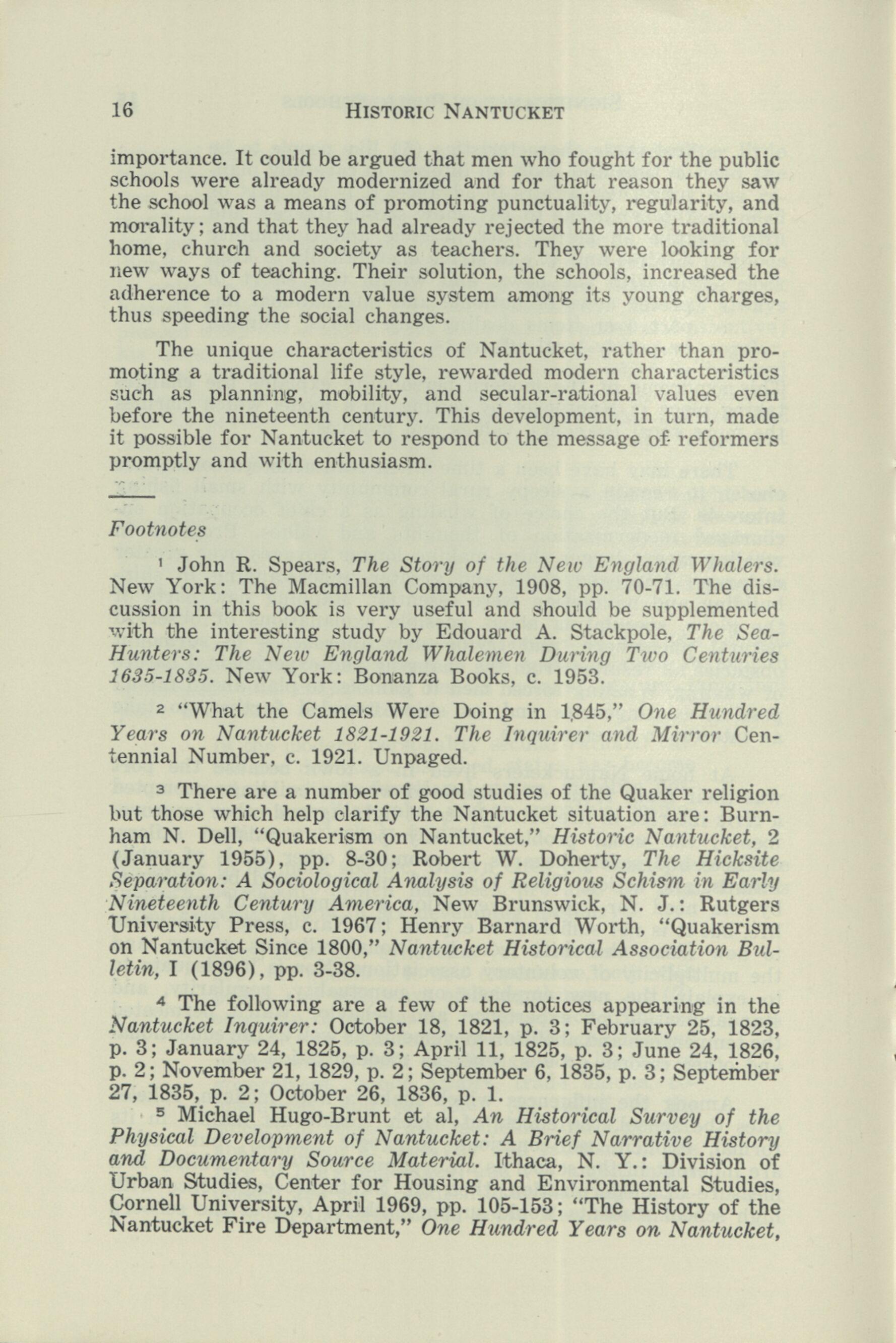
SIGNIFICANCE OF PUBLIC SCHOOLS 17
unpaged; Nantucket Inquirer, February 25, 1823, p. 3; November 4, 1823, p. 3; September 26, 1825, p. 2; December 12, 1825, p. 2; February 13, 1826 p. 2; March 11, 1826, p. 3; January 3, 1829, p. 2; June 6, 1829, p. 2. 6 United States Office of the Census, Compendium of the Enumeration of the Inhabitants and Statistics of the United States, as obtained at the Department of State, From the Returns of the Sixth Census, by Counties and Principal Towns, Exhibiting the Population, Wealth, and Resources of the County. Washington: Thomas Allen 1841. 7 J. Hector St. John de Crevecoeur, Letters from an American Farmer. New York: E. P. Dutton & Co., Inc., 1957, pp. 109-110. 8 Nantucket Inquirer, May 20, 1826, p. 2; there is a discussion of all of the objections to public schools. » Ibid., March 31, 1827, p. 2; March 29, 1828, p. 2. Emily Weeks, "Development of Schools in Nantucket," Proceedings of the Ninth Annual Meeting of the Nantucket HistoHcal Association, July 21, 1903, p. 15. 10 Quidam, "On Public Instruction," Nantucket Weekly Magazine: Literary and Commercial, July 12, 1817, p. 10. '1 Nantucket Inquirer, March 8, 1828, p. 2. '2 Records from 1838 to 1840 of the Town of Nantucket, pp. 198-9; "School Education," Talk given to Nantucket Philosophical Institute, n.d., M.S. in folder, "Schools — Walter Folger, Jr. Collection" at Foulger Museum, Nantucket; Cyrus Peirce and others, "Address to the Inhabitants of Nantucket on Education' and Free Schools," (Providence: Knowles, Vose & Company, 1838) ; Inquirer: October 18, 1837, p. 2; October 21, 1937, p. 3; January 13, 1838, p. 3; June, 1842, p. 2. '3 Mary Tyler Mann, Life of Horace Mann, By His Wife. Boston: Walker, Fuller and Company, 1865, p. 119. '4 Henry Barnard, ed. "Common Schools in Cities," Connecticut Common School Journal, IV, (December 1, 1841), pp. 14-15. is Reports of the School Committee of the Town of Nantucket for the Years Ending 1841, 1842, 1843, 1844, 1845, 1846, 1847. The segregation issue is a recurring theme during these years, the School Committee elections drew large voter participation and the Committee members changed every year as first one side and then the other side gained the upper hand. The Records of the town are also informative during this period. •6 Report of a Committee of Teachers, appointed by the School Committee of Nantucket, to Consider the Subject of Sys-
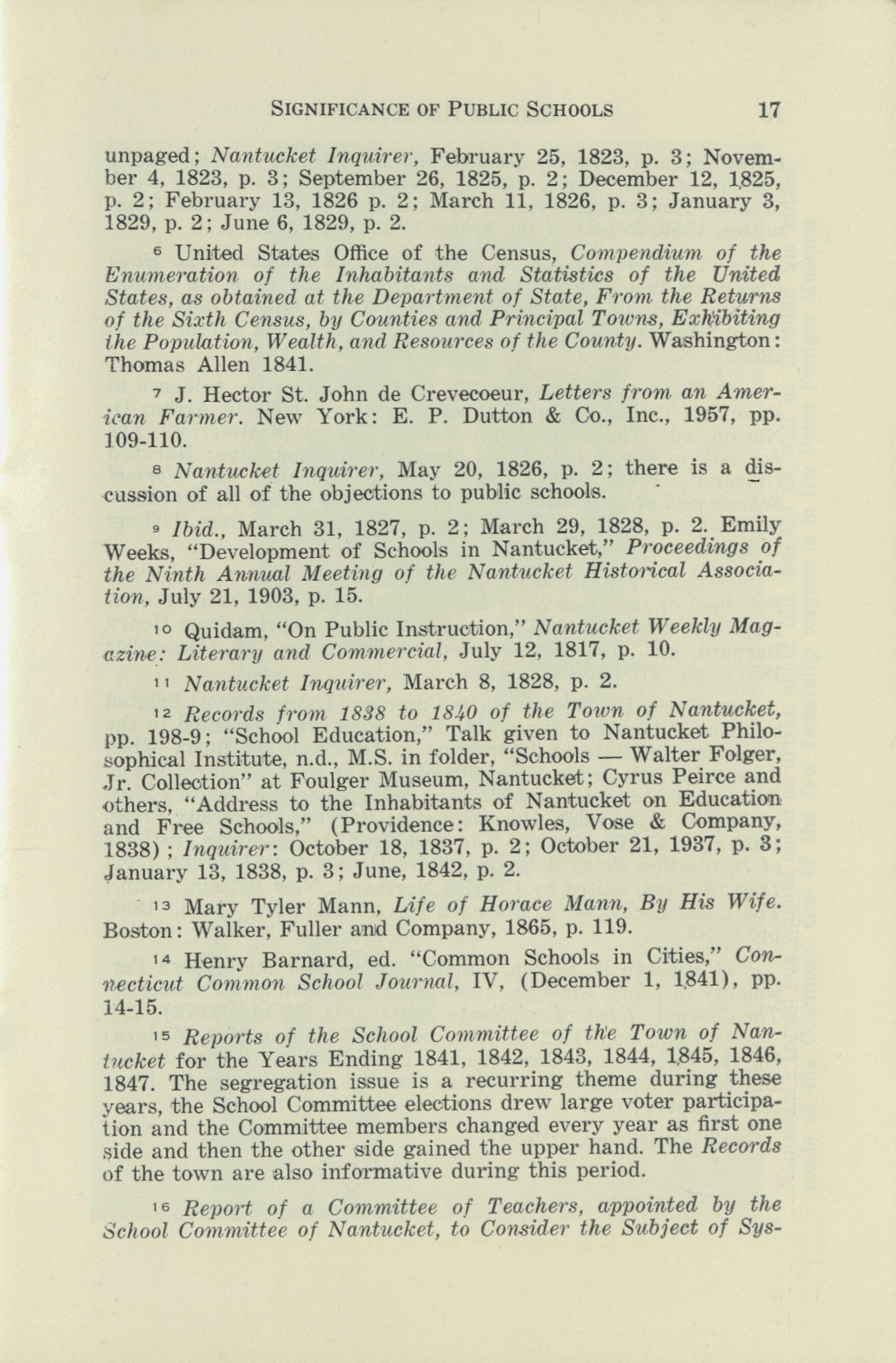
38
HISTORIC NANTUCKET
tematizing a Course of Studies, To Be Pursued in the Public Schools of That Toivn, and to Prepare a Programme of Such Studies. Nantucket: Printed by Authority of the School Committee, 1855. Report of the School Committee, 1859, p. 4. 17 Catalogue of Names, Embracing All Scholars Who Have Ever Been Pupils of the Nantucket High School, From Its Organization, April 16, 1838, to the Present Time, July 1, 1865. Nantucket : Hussey & Robinson, Printers — Inquirer and Mirror Office, 1865. 18 Peirce and others, p. 23; there is supportive evidence to show that Peirce continued to express these beliefs in Arthur 0. Norton, ed., The First State Normal School in America: The Journals of Cyrus Peirce and Mary Sivift. Cambridge: Harvard University Press, 1926. Also see Henry Barnard, ed., Normal Schools and othei* Institutions, Agencies, and Means designed for the Professional Education of Teachers, I. Hartford: Case, Tiffany and Company, 1851, p. 75. 19 Quoted in Samuel J. May, Memoir of Cyrus Peirce, First Principal of the First State Normal School in the United States. Hartford: F. C. Brownell, n.d. pp. 32, 33. [A Reprint from Henry Barnard, ed., American Journal of Education, XI (December 1857), pp. 273-308.] 20 Cyrus Peirce, Crime: Its Cause and Cure. Boston: Printed by John Wilson and Son, 1854. This paper was presented to the American Institute of Instruction in 1853 and the flurry whch it caused is reflected in Michael B. Katz, The Irony of Early School Reform: Educational Innovation in Mid-Nineteenth Century Massachusetts. Cambridge, Massachusetts: Harvard University Press, 1968, pp. 115-160. See also The Annals of the American Institute of Instruction Being a Record of Its Doings for 51+ Years, from 1830 till 1883, edited by Charles Northern!. New Britain, Conn.: The Case, Lockwood & Brainard Co., of Hartford, Conn., 1884, pp. 81-83. 21 Richard D. Brown, "Modernization and the Modern Personality in Early America, 1600-1865: A Sketch of a Synthesis," The Journal of Interdisciplinary History. II (Winter 1972), 201. 22 Ibid., pp. 215-216; Alex Inkeles, "Making Men Modern: On the Causes and Consequences of Individual Change in Six Developing Countries," American Journal of Sociology. 75 (September 1969), 210. 28 Inkeles, pp. 212-217.
